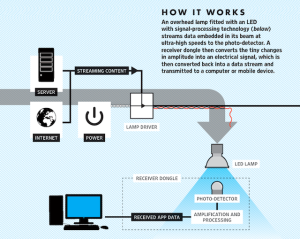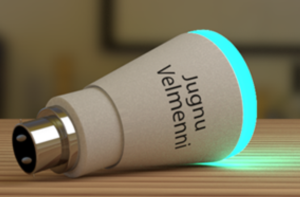Peter Lobner
Professor Harald Haas (University of Edinburgh) invented Li-Fi wireless technology, which is functionally similar to radio-frequency Wi-Fi but uses visible light to communicate at high speed among devices in a network. Professor Hass is the founder of the company PureLiFi (http://purelifi.com), which is working to commercialize this technology. The following diagram from PureLiFi explains how Li-Fi technology works.
A special (smart) LED (light-emitting diode) light bulb capable of modulating the output light, and a photoreceptor connected to the end-user’s device are required.
You can see Professor Hass’ presentation on Li-Fi technology on the TED website at the following link:
http://www.ted.com/talks/harald_haas_wireless_data_from_every_light_bulb?language=en#t-233169
Key differences between Li-Fi and Wi-Fi include:
- Li-Fi is implemented via a smart LED light bulb that includes a microchip for handling the local data communications function. Many LED light bulbs can be integrated into a broader network with many devices.
- Light bulbs are everywhere, opening the possibility for large Li-Fi networks integrated with modernized lighting systems.
- Li-Fi offers significantly higher data transfer rates than Wi-Fi.
- In an industrial environment, Estonian startup firm Velmenni has demonstrated 1 GBps (gigabits per second). Under laboratory conditions, rates up to 224 gigabits/sec have been achieved.
- Li-Fi requires line-of-sight communications between the smart LED light bulb and the device using Li-Fi network services.
- While this imposes limitations on the application of Li-Fi technology, it greatly reduces the potential for network interference among devices.
- Li-Fi may be usable in environments where Wi-Fi is not an acceptable alternative.
- Some hazardous gas and explosive handling environments
- Commercial passenger aircraft when current wireless devices must be in “airplane mode” with Wi-Fi OFF.
- Some classified / high-security facilities
- Li-Fi cannot be used in some environments where Wi-Fi can be successfully employed.
- Bright sunlight areas or other areas with bright ambient lighting
You can see a video with a simple Li-Fi demonstration using a Velmenni Jugnu smart LED light bulb and a smartphone at the following link:
The radio frequency spectrum for Wi-Fi is crowded and will only get worse in the future. A big benefit of Li-Fi technology is that it does not compete for any part of the spectrum used by Wi-Fi.

